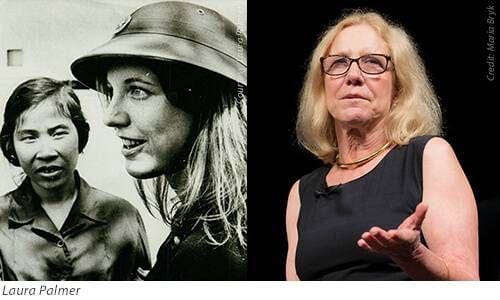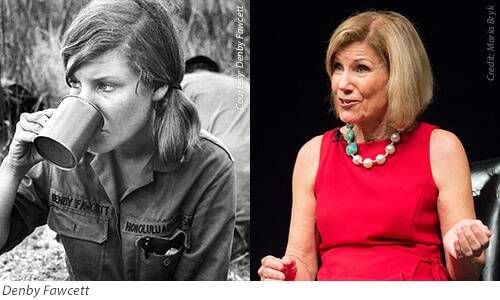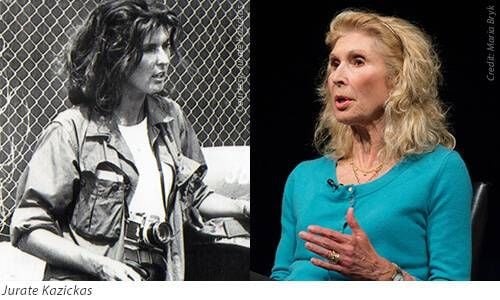The Women Who Covered Vietnam
Four female reporters tell how the front lines changed them
When Laura Palmer entered Oberlin College in the fall of 1968, she deeply opposed the war in Vietnam. Four years later, she'd be on her way there — the last place she expected to go.
Denby Fawcett felt bored on her party/gardening/cooking beat at her Honolulu, Hawaii newspaper. She was so low in the pecking order she wrote about parties the party reporter didn't want to cover. Determined to write substantial news from Vietnam, she pitched her bosses on sending her there. When they laughed, she quit and paid her own way over.
As did Jurate Kazickas, a magazine researcher whose boss refused to send her to the war zone, saying she was a woman and inexperienced. She spent her $500 winnings from the TV game show Password on a one-way ticket to Saigon.
And Edith Lederer, an Associated Press reporter in San Francisco, Calif. who kept filling out an annual company form saying she wanted to be a foreign correspondent, had to get past a foreign editor who refused to have a woman on his desk, the prerequisite to getting posted abroad. Eventually, she figured out a way.
Four women. Each improbably ended up in Vietnam, covering one of America's most unpopular wars.
Forty years after the end of that conflict, they appeared together this week at Washington D.C.'s Newseum to tell their stories of their time there, the lasting impact of that experience and the role of women in reporting on a war that defined a generation.
Sexism, Prejudice, Antagonism
Of the four, Palmer calls herself the "accidental reporter." She had thoughts of going to law school to defend the Black Panthers. But while hitchhiking with her younger sister the summer between her junior and senior years, the Highway Patrol told them they'd be arrested if they kept their thumbs out.
"So I said to my sister, ‘The next car has got to be it,’" Palmer said. "In the only movie moment of my life, the next car — a dilapidated green Chevy with fishing poles — stops." It was a pediatrician, a "hippie, Jewish doctor," as Palmer described him, who wanted to travel and work abroad. She fell in love with him and after graduation, followed him to Vietnam, where he had a job.

Palmer needed work, too, so she made the rounds of Saigon news bureaus. As a 22-year-old college grad whose only experience was as a "copy boy" in the NBC Washington bureau, she was greeted with a "litany of nos,” until she landed at the ABC News Saigon bureau.
It was around the time a group of women at The New York Times were protesting pay disparities with men. That lead to a sex discrimination suit the Times later settled. ABC saw it could have faced a similar situation.
"It was clear the station needed women on the air from Saigon, a quick fix to solve a much larger problem,” Palmer said. She was hired as a freelancer. But the Saigon bureau chief was less than welcoming. "The first words out of his mouth: 'Of all the applicants, you were the least qualified.' I wanted to die," she said.
Fateful Decisions
Fawcett’s background was different, but she, too, faced adversity. Although for a woman reporter in Vietnam "it was easy to be accredited and you were free to travel all over on the military's dime,” Fawcett said, “in order to go out with a unit, you needed the commander's permission. I was 24 and one said to me, ‘I would never let you come out because you remind me of my daughter.’ And you think, 'Holy cow.' They wouldn't say, 'You remind me of my son. You might get killed.' There was so much prejudice against women in our era."

In 1968, Kazickas made a fateful decision to break her rule that as a freelancer she would never go where the rest of the press was and paid dearly. The Battle of Khe Sahn was too big a story to avoid. WOR Radio sent her to interview New Yorkers who were among the Marines under siege. "I hitched a ride on a helicopter, blades whirring. When I arrived, the public information officer (PIO) was furious since I was not on his official roster," she said.

As Kazickas was about to interview some Marines, an artillery shell came in. Instead of lying flat, she ran for a foxhole and took shrapnel to her legs, face and back. “The PIO [Public Information Officer] said later, 'She got was she was looking for.' But that was not quite what I was looking for," she told the Newseum audience.
Living History
Despite the sexism of the day, there were also amazing opportunities for women at the dawn of women's liberation. In 1972, Lederer, still pushing to be a foreign correspondent, finally got a call from the president of AP asking her if she wanted to go to Vietnam. She could skip the foreign desk.
She set off and was later assigned to cover the release of the first American POWs held by the Viet Cong. "These totally bedraggled American soldiers got off the helicopter, some limping, many emaciated, some seeming to not know where they were,” she recalled. “As they got off, an American general saluted every one of them and almost every one saluted back. At that moment, seeing an American general, they realized they were free. It was an incredibly moving experience."
Lederer would go on to cover the Yom Kippur War and other conflicts. Nearly 50 years after joining AP, Lederer raced off after the Newseum event to return to New York to cover the visit of the Joint Chiefs of Staff Chairman as AP's Chief United Nations Correspondent.

Palmer stayed for two years through President Nixon's resignation, a day she was alone in the NBC bureau and coordinating coverage. She would return to witness the final days of American involvement in Vietnam in April 1975. Saigon, she said, was where “I did work that I really loved for the first time, where I met friends I loved and felt for the first time I mattered in life."
The War Is In Us
Palmer has never understood why people say Vietnam is behind us. "It's in us," said the author of Shrapnel in the Heart , which traces letters left at the Vietnam Memorial in Washington to some of the more than 58,000 names on the wall
Palmer, Lederer, Fawcett and Kazickas are among nine women reporters who reflected on their time in Vietnam in War Torn ,p ublished in 2002. Since then, it's become more common to see women reporting from combat zones in Iraq and Afghanistan. "I don't think we have gender bias any more. I may be wrong," Kazickas said.
Given that war reporting was a male bastion in the '60s and '70s, you might assume women reporters in Vietnam downplayed their gender. On the contrary, said Kazickas. She recalled: "It was important for me to still have some femaleness out there. I would always wear a yellow T-shirt under my fatigues and I did put on lipstick surreptitiously every now and again. One of the nicest compliments I got after a couple of days on patrol in the rain and mud came from a guy in the foxhole where we slept. 'Ma'am,' he said, 'I don't know how you do it but you still smell better than we do.'"

